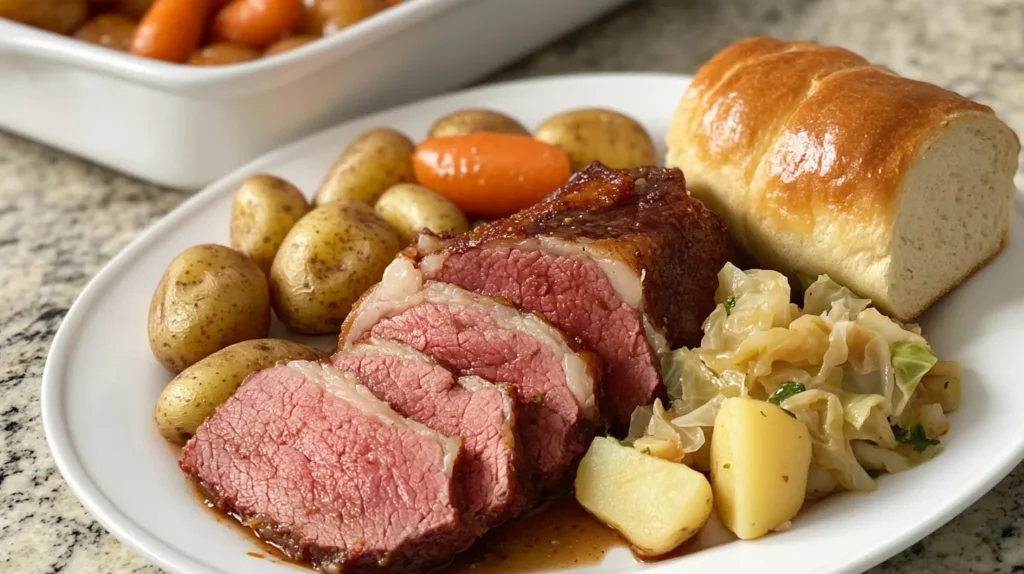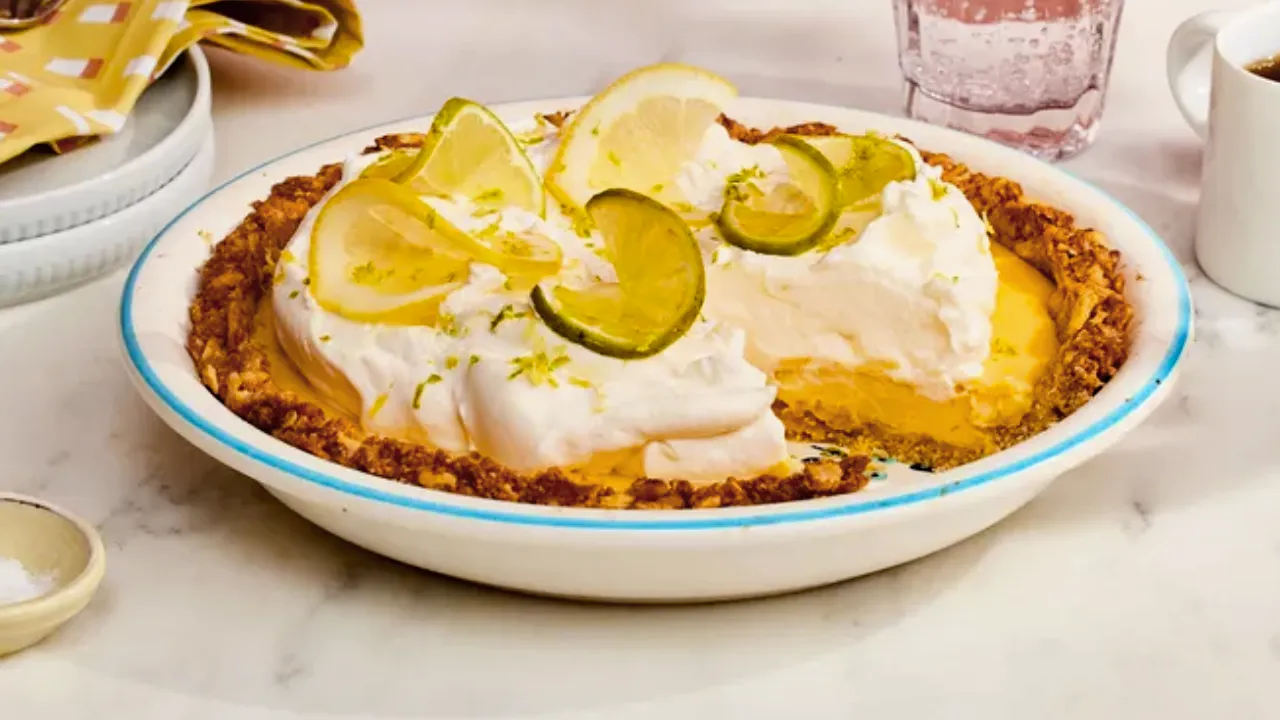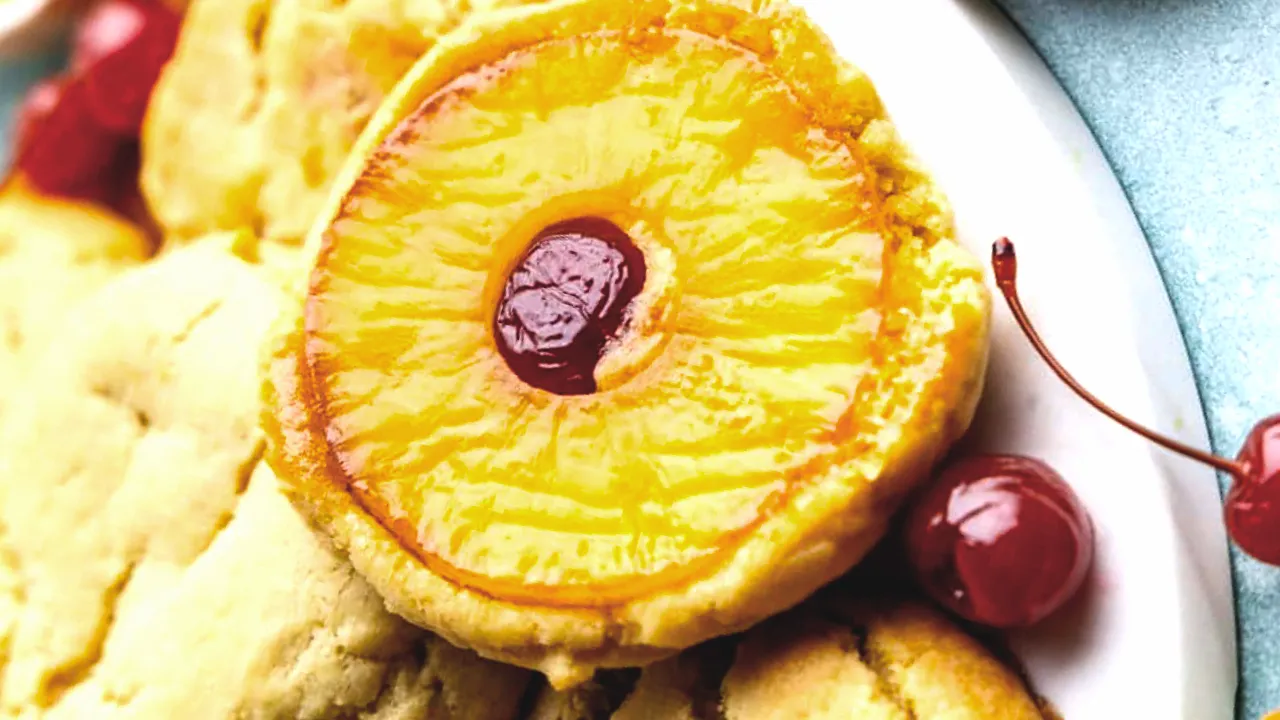Ever wondered why your oven-baked corned beef turns out tough instead of melt-in-your-mouth delicious? What if you could unlock the secret to creating the most tender Irish cuisine masterpiece right in your own kitchen?
Discover the art of preparing the perfect oven-baked corned beef with cabbage. This classic recipe turns a simple 4-pound brisket into a mouth-watering meal for 6-8 people. It promises a culinary experience that will impress your family and friends.
Forget about boiling – oven-baking is the key to achieving that perfect, juicy texture. With just 20 minutes of preparation and about 4 hours of cooking time, you’ll create a dish that celebrates the rich traditions of Irish-American cuisine.
Key Takeaways
- Oven-baking guarantees more tender corned beef compared to traditional boiling
- Perfect for 6-8 servings with a 3-4 pound brisket
- Total cooking time is approximately 4 hours
- Ideal internal temperature ranges between 160-185 degrees Fahrenheit
- Preparation time is just 20 minutes
Understanding Corned Beef: History and Tradition
Corned beef has a rich history that goes beyond just being a St. Patrick’s Day dish. It started with Irish immigrants in America in the 19th century. They found a new food world that changed their traditions.
The story of corned beef shows a big cultural shift. Irish immigrants lived near Jewish communities. This led to a new food tradition.
Origins in Irish-American Cuisine
Corned beef wasn’t common in Ireland. It became popular in the U.S. because of certain reasons:
- Beef was cheaper in America than in Ireland
- Irish immigrants bought brisket from Jewish butchers
- It was a cheap protein for working-class families
Why “Corned” Beef?
The word “corned” might seem odd, but it’s simple. Corning means using big salt crystals. These salt grains, like corn, named the meat and preserved it.
Traditional Significance in St. Patrick’s Day Celebrations
Now, corned beef is a key part of St. Patrick’s Day. It shows the strength and adaptability of Irish-American culture. What started as a practical choice is now a beloved dish that unites people.
Essential Ingredients for Perfect Oven-Baked Corned Beef
Starting a delicious corned beef recipe is all about the ingredients. Your journey to comfort food begins with picking the best parts. These will turn a simple meal into a memorable dish.
To make the perfect oven-baked corned beef, you need a few key ingredients:
- 3-4 pound pre-brined corned beef brisket
- Corned beef spice packet (included with brisket)
- 5 large carrots
- 24 ounces baby gold potatoes
- 1 small head of cabbage
- ½ cup Guinness beer or beef broth
- 2 tablespoons whole grain mustard
- 2 tablespoons light brown sugar
The secret to tender, flavorful corned beef is in quality ingredients and proper preparation. The spice packet is key. It adds a blend of pickling spices that make the meat taste amazing.
| Ingredient | Quantity | Purpose |
|---|---|---|
| Corned Beef Brisket | 3-4 pounds | Main protein |
| Brown Sugar | 2 tablespoons | Balance meat’s saltiness |
| Whole Grain Mustard | 2 tablespoons | Add tangy flavor |
| Braising Liquid | ½ cup | Keep meat moist |
Pro tip: Pick a fresh corned beef brisket with good marbling. This makes your comfort food juicy and full of flavor. Prep time is just 10 minutes, making it both tasty and easy!
Choosing the Right Cut of Corned Beef
Choosing the right cut of corned beef is key to a delicious dish. It becomes the star of your comfort food. Knowing the differences between cuts helps you pick the best for your meal.
Flat Cut vs Point Cut: What You Need to Know
When you go shopping, you’ll find two main cuts:
- Flat Cut: Leaner and more uniform in shape
- Point Cut: More marbling and intense flavor
Understanding Meat Quality and Characteristics
The point cut is often cheaper and has more flavor. It has more fat, making it juicier and tender. A 3-pound point cut brisket cooks for about 1 hour per pound.
Size and Serving Recommendations
Here are some tips for planning your meal:
- Serving size: About 3/4 pound per person
- Typical brisket weight: 3 pounds
- Recommended internal temperature: 185°F
Whether you pick the flat or point cut, your corned beef will be a hit. It will make your comfort food dish unforgettable.
The Perfect Spice Blend and Seasonings
To make the best corned beef, you need the right mix of Irish spices. This blend turns a simple brisket into a dish to remember. It’s all about picking the right spices and mixing them just right.
Your spice mix should have these important parts:
- 1 tablespoon mustard seeds (14.3 grams)
- 1 teaspoon black peppercorns (2.3 grams)
- 1 tablespoon ground coriander (6.5 grams)
- 4 whole cloves (2.4 grams)
- 4 crushed bay leaves (1.5 grams)
- 0.5 teaspoon crushed red pepper flakes (2.3 grams)
McCormick® Mixed Pickling Spice is a great pre-mixed choice for corned beef. Pro tip: If your corned beef doesn’t come with a seasoning packet, you can make your own.
This spice mix works wonders on a 3 to 4-pound brisket. It adds layers of flavor that will wow everyone. Mustard seeds add a sharp taste, bay leaves bring depth, and red pepper flakes add a touch of heat.
Remember, the secret to great corned beef is finding the right balance. Play with the amounts until you get your ideal mix in this Irish favorite.
Oven-Baked Corned Beef with Cabbage
Making oven-baked corned beef with cabbage is all about precision and care. This classic dish turns a simple meal into a memorable experience. It will surely delight your family and guests.
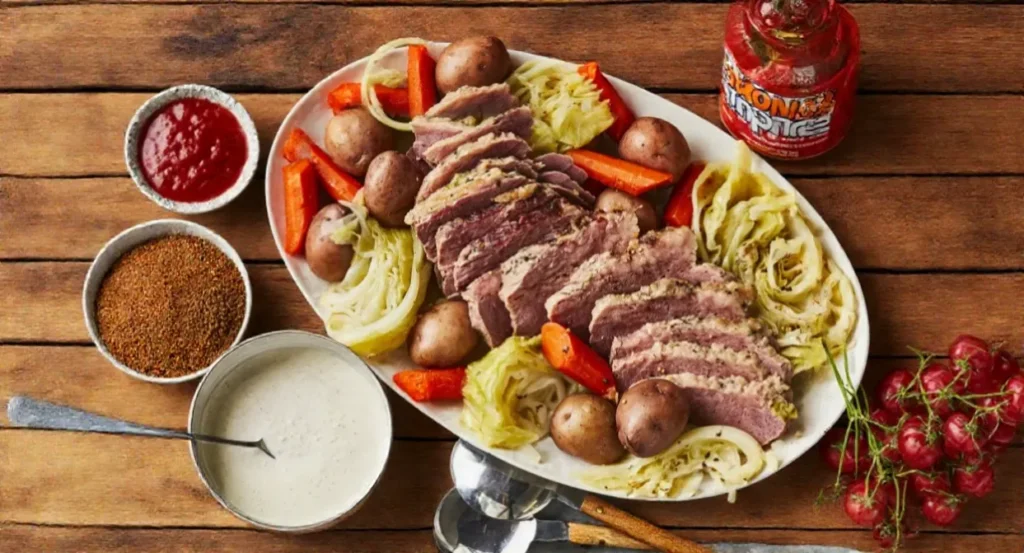
Are you ready to make a tender and flavorful corned beef? The secret is in the right cooking techniques and following key guidelines.
Temperature and Timing Guidelines
Your journey to oven-baked corned beef starts with temperature control. Here’s what you need to do:
- Preheat the oven to 325°F
- Cook for about 1 hour per pound of meat
- Target an internal temperature of 190°F to 205°F
- Total cooking time is around 3-3.5 hours for a 3.5-4 pound brisket
Proper Preparation Steps
Preparing your slow-cooked meat needs attention to detail:
- Rinse the corned beef brisket well
- Pat the meat dry with paper towels
- Put the beef fat side up in a roasting pan
- Add about 4 cups of water to the pan
- Cover the pan tightly with aluminum foil
Cooking Techniques for Tenderness
For maximum tenderness, use these expert techniques:
- Keep the meat covered for the first 1.5 hours
- Uncover and add vegetables for the last cooking time
- Baste the meat often to keep it moist
- Let the meat rest for 10-15 minutes after cooking
By following these steps, you’ll make a delicious oven-baked corned beef with cabbage. The secret is patience, precise temperature control, and proper preparation.
Preparing and Seasoning Fresh Vegetables
Choosing the right vegetables is key to a tasty one-pot meal with corned beef. A fresh cabbage side dish can turn a simple meal into a special occasion. Pick firm veggies like carrots, potatoes, and cabbage to go with your corned beef.
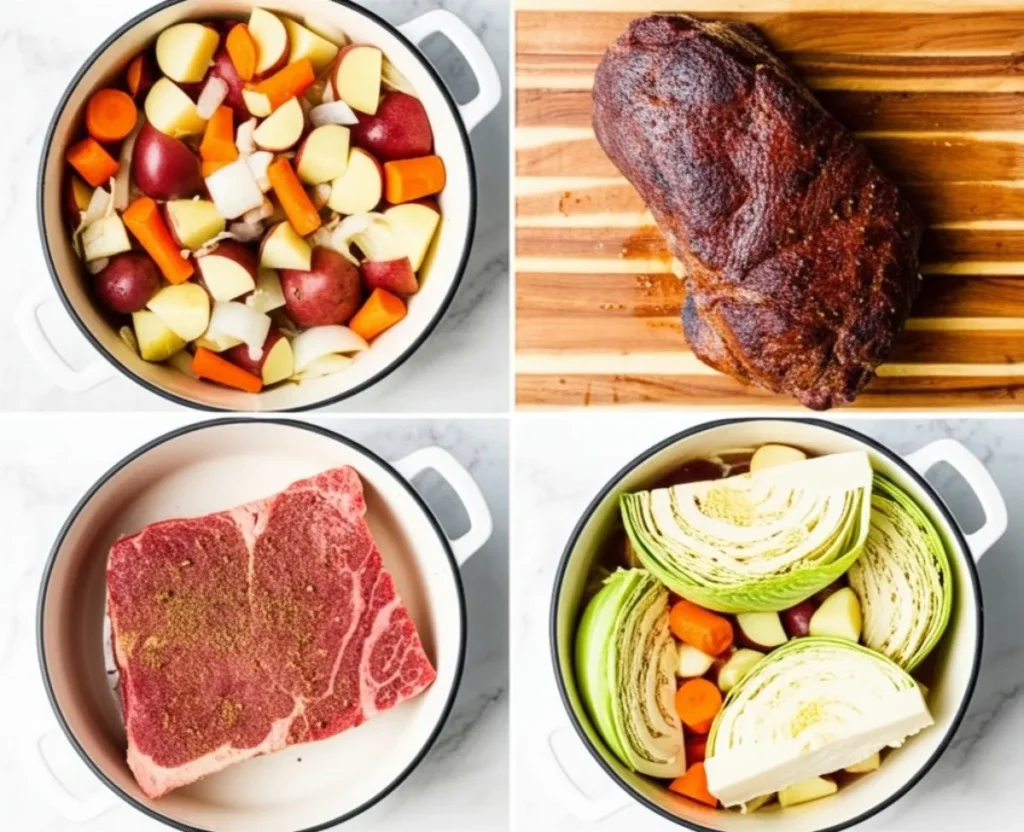
- Wash all vegetables thoroughly
- Cut vegetables into uniform, bite-sized pieces
- Ensure pieces are roughly the same size for even cooking
For seasoning, make a simple yet tasty mix. Mix melted butter with:
- Fresh cracked black pepper
- Kosher salt
- Optional horseradish for extra kick
Pro tip: Toss your veggies in this seasoned butter before roasting. This way, every bite is full of flavor. It also makes your cabbage side dish golden and caramelized.
When adding veggies to your corned beef, timing is everything. Add carrots and potatoes early. Save cabbage wedges for the last 30-45 minutes to avoid overcooking.
Mastering the Horseradish-Butter Sauce
Creating the perfect sauce for your corned beef can make it truly special. The horseradish-butter sauce adds a zesty kick. It cuts through the rich flavors of the meat, creating a delightful balance.
Ingredient Proportions for the Perfect Sauce
To make an exceptional horseradish-butter sauce, you need the right mix:
- 3 tablespoons unsalted butter, melted
- 1/4 cup prepared horseradish
- 1 tablespoon cider vinegar
- 1 tablespoon sugar
- Salt and pepper to taste
Mixing and Application Methods
Start by whisking together the melted butter, horseradish, vinegar, and sugar. The goal is a smooth mix that complements your corned beef.
For the best taste, apply the sauce just before serving. Drizzle it over the sliced corned beef. This lets the sauce blend with the meat’s juices. Each bite will be full of flavor, making your meal feel like a restaurant dish.
Pro tip: For a milder sauce, use less horseradish or add sour cream. This will soften the heat. Your guests will love this simple yet sophisticated touch to your corned beef!
Perfect Timing: When to Add Vegetables
Creating a perfect one-pot meal needs precise timing. This is true for a traditional boiled dinner with corned beef and vegetables. Knowing when to add each vegetable is key. This ensures they cook just right, without being mushy or undercooked.
For your oven-baked corned beef dish, follow these essential vegetable timing guidelines:
- Hard vegetables like potatoes and carrots go in first
- Cabbage should be added during the last 30-40 minutes of cooking
- Cut vegetables into large, uniform chunks for even cooking
Your vegetable strategy depends on the total cooking time of the corned beef. A 3-pound brisket takes about 3 hours to cook. You’ll want to add vegetables at the right time:
- Initial 2½ hours: Cook corned beef alone
- Last 30-40 minutes: Add prepared vegetables
- Total cooking time: 3 hours
Pro tip: Quartered onions and baby carrots can handle longer cooking times. Cabbage, on the other hand, needs less time to become tender. By adding vegetables at different times, you’ll make a balanced one-pot meal. This meal will highlight the rich flavors of your oven-baked corned beef.
Proper Slicing Techniques and Presentation
Learning to slice your corned beef is key for a stunning St. Patrick’s Day meal. The right way to cut can make your dish go from good to great.
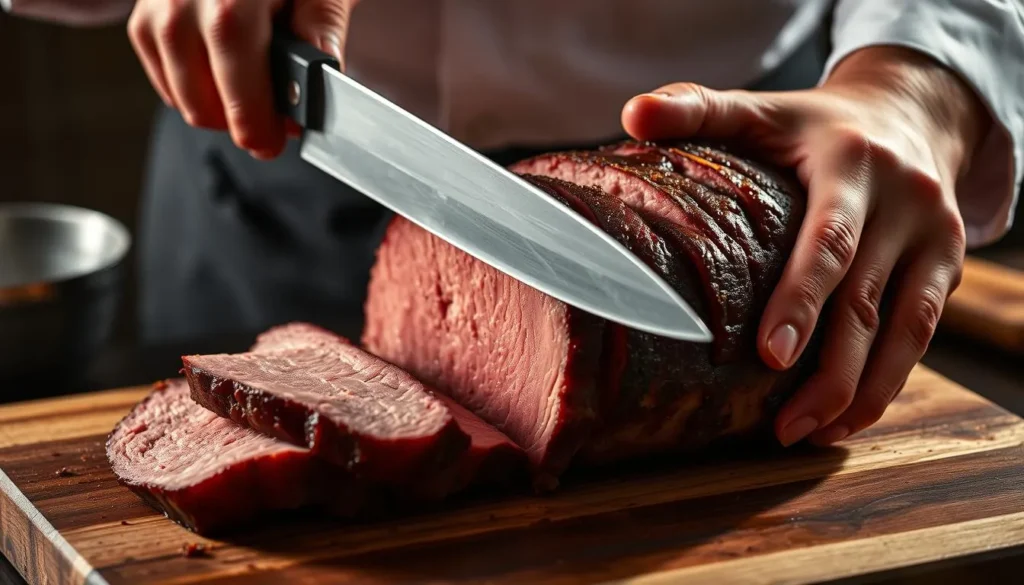
Let your cooked corned beef rest for about 10 minutes before slicing. This step helps keep each slice moist and full of flavor.
Cutting Against the Grain
For tender corned beef, cut against the grain. Here’s how to do it right:
- Find the meat fibers’ direction
- Place your knife across those fibers
- Cut into even ¼-inch thick slices
Plating for Maximum Appeal
Great presentation can turn a simple dish into a masterpiece. Here are some tips for your St. Patrick’s Day meal:
- Arrange slices in a fan pattern
- Surround with colorful roasted veggies
- Add fresh herbs as garnish
- Pair with horseradish sauce
A beautifully sliced and presented corned beef dish is not just tasty. It also makes for a memorable meal that honors traditional recipes.
Storage Tips and Leftover Ideas
Your oven-baked corned beef doesn’t have to end after one meal. It’s a traditional dish that can be turned into many new dishes. This keeps your taste buds excited.
Storing your corned beef right is important to keep its taste and quality. Store it in an airtight container in the fridge for 3-4 days. This way, you’ll have tasty protein for quick meals all week.
Leftover Storage Guidelines
- Refrigerate within 2 hours of cooking
- Use airtight containers
- Keep refrigerated at 40°F or below
- Consume within 3-4 days
Creative Leftover Ideas
- Corned Beef Hash: Dice leftover meat and crisp it up with potatoes for a hearty breakfast
- Reuben Sandwiches: Layer thin slices on rye bread with sauerkraut and Swiss cheese
- Corned Beef Casserole: Mix with vegetables and cheese for a comforting dinner
- Salad Topper: Slice thinly and add protein to your favorite green salad
When reheating, use low temperatures to prevent drying out. A gentle warming in the oven at 350°F for about 10-15 minutes will help maintain the meat’s tenderness and flavor.
Nutritional Considerations
| Nutritional Value (per 1/4 lb serving) | Amount |
|---|---|
| Calories | 282 |
| Protein | 18.7g |
| Fat | 17.2g |
| Carbohydrates | 13.6g |
Don’t let your corned beef go to waste! With these storage tips and creative ideas, you’ll transform leftovers into exciting new meals that everyone will enjoy.
Troubleshooting Common Issues
Preparing slow-cooked meat like corned beef can sometimes present challenges, even for experienced home cooks. Understanding potential pitfalls will help you create the perfect dish every time.
When working with corned beef recipes, several common issues can arise:
- Tough Meat: Low and slow cooking is crucial. Cooking at high temperatures can result in a chewy texture.
- Excessive Saltiness: Rinsing the meat before cooking can help reduce salt content.
- Uneven cooking: Ensure the meat is fully submerged in liquid during preparation.
Key troubleshooting tips for perfect corned beef include:
- Maintain a consistent low temperature around 180°F (82°C)
- Cook for appropriate duration – typically 3-4 hours for a three-pound cut
- Always slice against the grain to ensure tenderness
Temperature and timing are critical in preparing tender slow-cooked meat. At 180°F, you’ll achieve optimal moisture retention and softness. Pro tip: If your corned beef turns out tough, it likely means it wasn’t cooked long enough or at too high a temperature.
Remember that patience is key when preparing corned beef recipes. Gentle, prolonged cooking will transform your brisket into a mouthwatering, tender meal that will impress your family and friends.
Conclusion
Making oven-baked corned beef with cabbage is more than cooking. It’s about connecting with tradition through food. You’ve learned how to turn a simple 3.2-pound brisket into a tasty St. Patrick’s Day feast. This feast will surely impress your family and friends.
You’ve picked up more than just cooking skills. You now know how to get the meat to 160°F and how to season it perfectly. Slow-roasting makes the meat tender and flavorful. This makes your dish a standout in your cooking collection.
This recipe is great for celebrating Irish heritage or just enjoying a comforting meal. Remember, cooking is an art. With practice, you’ll add your own special touch. Enjoy the smells in your kitchen and relish every bite of your dish.
Your new skills will make this St. Patrick’s Day meal unforgettable. It will honor tradition and your own cooking style.

